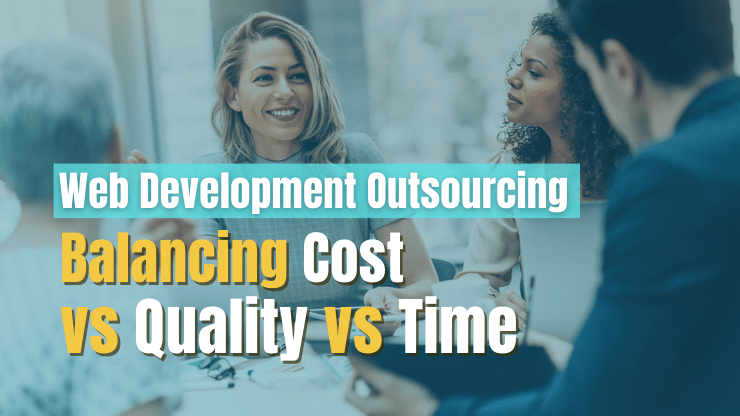Over 50% of companies site performance or compatibility issues as the reason for ending outsourcing partnerships. These issues are far from the only risks that could plague your outsourced software project.
The more proactive you are in acknowledging the software development risks, the more effective you’ll be at managing them.
We’ll help you kickoff your risk assessment by covering the top 7 risks we see time and time again when teams outsource software development. Manage these and you’ll be well on your way to protecting your project and ensuring successful software delivery.
Managing the top 7 risks of outsourcing
The risks of outsourcing software development can generally be divided into seven categories. As we walk through them, consider what matters most to your organization. What risks can you tolerate and what risks need to be managed more closely?
Risk management is complex, and it should be handled in a way that ultimately supports your business goals.
Lack of control
Doing business with outside vendors is likely nothing new to you. But handing over control to an unknown vendor can nonetheless be disconcerting.
With outsourced software development, it’s important to consider the risks of not controlling the every-day management of the project. The team will lose a level of visibility and control. That’s a given.
This, in many ways, is where the value of outsourced development comes in, but if you’re not working with a team you trust, this value can quickly become a risk.
How do you hand over control effectively?
- Hire the right team. Take the time to source and select a software development company that you trust and is a good match for the project.
- Complete a “RACI” matrix to establish who owns what. This will help everyone know their lane and work within it over the course of the project.
- Establish transparency between parties. You will inevitably have to release some control, but the risk is lowered when you can trust the team to bring you concerns or issues early.
- Determine a communication cadence. Consistent touch points can help alleviate concerns of lack of control. Reports from the vendor will allow you a peak into their work process and overall project progress.
Communication issues
A recent study showed that nearly 90% of businesses believed communication to be one of the key challenges in the outsourcing process. Some communication challenges are inherent when working with distributed teams, but often the root of the issue is deeper. National and organizational culture differences and language barriers can be at play.

These issues can be further compounded by the client-service provider dynamic, where outsourcing provider staff might feel compelled to be agreeable towards the client. This can cause teams to not speak up and challenge unachievable requests. What may seem like a communication issue was inherently a cultural issue.
Poor communication can wreak havoc on your project. It’s critical to be aware of these risks and find ways to proactively avoid miscommunication regardless of where it stems from.
How do you avoid miscommunication?
- Ensure that the outsourced team members have a strong command of English, using an established standard such as the Common European Framework of Reference (CEFR) and ensure that your contract states the appropriate minimum standard you require for any new resource.
- Make sure that leaders on the vendor side have excellent meeting facilitation skills. During meetings, they should be checking for understanding and asking attendees to confirm their alignment.
- Make use of face-to-face or video calls as a lot of communication can be non-verbal.
- Make sure that working patterns across time zones are agreed. If there is a significant time zone difference this can impact collaboration.
Poor quality software & services
One prominent outsourcing risk for many companies is the risk of receiving a bad end product. The ultimate goal is always working software, right? And, I’m certain you’d like to receive quality service along the way, too.
The trouble is you don’t 100% know what you’re going to get when you work with a new vendor. Any aim at cutting costs or saving development time could be shattered if you have to start over with a new company. As much as possible, you should aim to protect yourself from receiving poor quality service and software from your software vendor by doing some due diligence upfront.
How do you ensure you’ll get quality software?
- In short, go through a proper vetting process to find the right software development team.
- Don’t just look at the price tag. While cost-savings might be a priority, you should consider the full picture. Ultra low prices often result in significant headaches (and costs) down the road.
- Ask the outsourcing company for examples of previous work. See who they have worked with previously and what type of jobs they have done.
- Establish clear expectations with Service Level Agreement (SLA) that lists services provided by the outsourcing firm and their costs. This will serve as protection against quality issues down the line.
- Find or hire someone on your staff who can inspect the outsourced team’s work. A tech-savvy specialist on your side will help to guarantee the quality of the finished product code. This can reduce some of the risk of quality issues.
Lack of domain knowledge
Shared understanding between the client and software team is crucial if you want to achieve high quality software. It’s important that the client and service provider have adequate relevant domain and industry knowledge.
It’s important to understand that there's a risk of a lack of domain knowledge on both the client and service provider side.
On the client side, you could become dependent upon an outside vendor. You may eventually start to lose your product expertise and core competency if you outsource many projects or even all aspects of one project. It’s not unusual for clients to lose all touch with the product, market, or customer when they outsource development. This could become quite the issue long term for the client’s business.
Because of this, it can be helpful to retain some control over the project by outsourcing some but not all of the development. Or, you could consider hiring expert engineers or analysts to augment your team internally.
On the service provider side, you of course have the risk of working with a team that doesn’t come to the table with adequate domain knowledge for your project. Team members might have all the technical skills required, but they may lack product and specific domain knowledge that can result in costly education or even missed deadlines. A contractor’s expertise plays a significant role in their ability to deliver a quality end-product.
Depending on your project, you may want to look for a team who has specific experience in your market, sector, or domain.
Research into software team coordination has confirmed that the amount of domain knowledge across all team members is a key factor in software quality and cost. We recommend you prioritize knowledge transfer both at the beginning and end of any outsourced project. This sharing of information can be helpful for both the client and vendor to avoid losing (or never gaining) the necessary domain knowledge.
How do you ensure proper domain knowledge?
On the client side, we suggest you:
- Maintain deeply connected to the product, customers, and domain throughout development.
- Utilize outside vendors for some but not every aspect of new product development.
- Take the time to do a knowledge transfer at the end of the development lifecycle.
On the service provider side, ask questions about their previous clients:
- Who have they worked with previously?
- What industries have they done work for?
- Do they mostly do small projects? Only web development? App development?
- Do they focus on customer-facing software or internal software?
- Do they have experience in your specific market or with your target customers?
This is not to say that outsourcing firms with a wide range of customers and a company’s portfolio are the best for your use case. The key point is that the outsourcing partner should have experience in your line of business. If the software development company claims to have experience doing something similar to what you want, but can’t share any information, then this can be a red flag.
It’s true that outsourcing companies may not always be able to share their previous projects due to non-disclosure agreements. However, they should at least be able to give you a broad outline of their previous projects, how they were developed, and how they benefit the clients.
Unexpected costs
Utilizing an outsourcing model for development is often expected to reduce costs. Vendors can offer economies of scale with a fully-staffed development team. Some companies may also offer lower labor rates, especially if you are looking overseas.
However, there is an old adage that says “buy cheap, buy twice.” And it is important to make sure that the costs saved up front don’t come back to bite you. Low cost can sometimes also mean low quality. It can also mean hidden costs. It’s best to avoid both.
How do you avoid unexpected costs?
- Ensure that you are as clear as possible from the beginning of the project about quality standards, on-site visits, and working overtime. Otherwise the vendor will spend costly time clarifying these things with you during the project.
- Make a decision about the third party’s operating model. A time and materials arrangement will tend to be at a lower day rate than a fixed price agreement. But in a fixed price model there will be more incentive for the third party to deliver on time. This could add some predictability into the equation for you.
- Watch for common third-party tactics such as adding extra team members to the project ($$$), or swapping out experienced “A Team” members for newer, less experienced team members. This is likely to extend delivery timelines and reduce efficiency ($$$).
- Establish a robust quantitative quality measurement process so that you can determine where quality has fallen short. It can be helpful to also establish a qualitative feedback loop that allows employees to highlight any concerns or improvement opportunities.
Lack of experience with remote teams
We're in an era where working remotely is becoming increasingly common. Many businesses are totally remote. Remote teams help companies to tap into a larger talent pool and allow everyone to work where and how they are most productive.

It sounds great, but if your team doesn’t have experience with remote work, you add risk to the equation. There can certainly be a learning curve when working with a remote team for the first time.
How do you work effectively with remote teams?
- Clearly define project success. Make sure everyone is crystal clear on what the project goals are and what would make the project a success. Ensuring this early alignment really helps to eliminate the risk of working in an unfamiliar way.
- Share a top-level user journey walkthrough. This urges the offshore team to adopt a more user-centric approach and better relate sprints/milestones deliverables to the big picture.
- Over communicate. Assign someone in-house to be the main point of contact. This person can answer questions from the offshore team and communicate any changes to the project asynchronously. This can mimic the “hallway chats” of in-person work.
Read more: Managing Remote Engineering Teams — Best Practices & Tools
Security breaches and IP protection
You need to be aware of the risks of a vendor mismanaging your data or IP. Anytime you share sensitive information about your IT systems, you inherently reduce security. Of course this is often a risk that is necessary to take on, but it’s important to think through the implications before engaging with vendors.

Consider what kind of damage could be done if your data security practices or intellectual property (IP) rights are violated. Make sure you have your security practices and expectations documented in order to avoid any ambiguity.
Ultimately, you need to be willing to hold any outsourcing vendors accountable for security of your data and IP. You should plan to do a regular security risk assessment throughout your engagement with a software outsourcing company.
How to avoid data breaches and IP mismanagement?
- Enter into an non-disclosure agreement (NDA) with the vendor (following your local IP laws). Make sure this is in place before you share any confidential information.
- Conduct research on independent review platforms before entering into an agreement with a vendor. You should look into the vendor’s reputation and any past breaches of its clients’ intellectual property rights.
- Investigate the vendor’s internal risk practices, their ability to safeguard your IP, and what their response would be to a data breach within their organization.
- Check our Custom Software Development Contract Template Checklist
How to avoid outsourcing risks?
Outsourcing software development has been a common practice for well over 40 years, so the main risks are well understood. However, what’s tolerable risk for you will depend on your business conditions and specific project.

Conclusion
Outsourcing services can prove to be a very cost-efficient method of achieving your goals. But a detailed risk management plan should be in place. Risks should be acknowledged and mitigated to protect your business and ensure successful project delivery.
Acknowledge and manage the risks, but don’t allow them to dissuade you from utilizing outsourcing to grow your business strategically.
At SoftKraft we work closely with our clients to understand your unique business challenges, map out a strategic solution, and build software to your specifications so you can maximize your ROI every time.
If you are looking for a software development partner to help you minimize development risks, contact us today.







